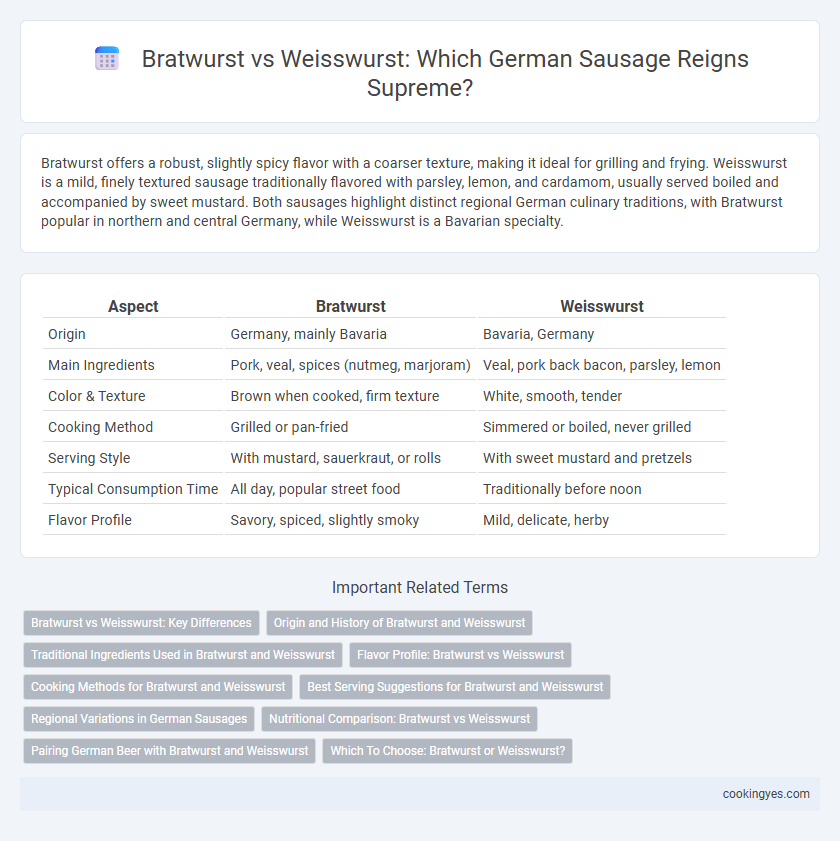Bratwurst offers a robust, slightly spicy flavor with a coarser texture, making it ideal for grilling and frying. Weisswurst is a mild, finely textured sausage traditionally flavored with parsley, lemon, and cardamom, usually served boiled and accompanied by sweet mustard. Both sausages highlight distinct regional German culinary traditions, with Bratwurst popular in northern and central Germany, while Weisswurst is a Bavarian specialty.
Table of Comparison
| Aspect | Bratwurst | Weisswurst |
|---|---|---|
| Origin | Germany, mainly Bavaria | Bavaria, Germany |
| Main Ingredients | Pork, veal, spices (nutmeg, marjoram) | Veal, pork back bacon, parsley, lemon |
| Color & Texture | Brown when cooked, firm texture | White, smooth, tender |
| Cooking Method | Grilled or pan-fried | Simmered or boiled, never grilled |
| Serving Style | With mustard, sauerkraut, or rolls | With sweet mustard and pretzels |
| Typical Consumption Time | All day, popular street food | Traditionally before noon |
| Flavor Profile | Savory, spiced, slightly smoky | Mild, delicate, herby |
Bratwurst vs Weisswurst: Key Differences
Bratwurst and Weisswurst are iconic German sausages distinguished primarily by their ingredients and preparation methods. Bratwurst typically consists of pork, veal, or beef, and is seasoned with spices like marjoram, then grilled or fried for a crispy outer texture, while Weisswurst is made from finely minced veal and pork back bacon, flavored with parsley, lemon, and cardamom, usually boiled and served with sweet mustard. The distinct taste profiles and cooking techniques make Bratwurst heartier and more robust, whereas Weisswurst offers a milder, delicate flavor ideal for traditional Bavarian breakfast.
Origin and History of Bratwurst and Weisswurst
Bratwurst, originating from the Franconia region in Germany during the 14th century, is traditionally made with pork and veal, seasoned with spices like marjoram. Weisswurst, a Bavarian specialty dating back to the early 19th century, is a white sausage primarily composed of finely minced veal and pork back bacon, flavored with parsley, lemon, and cardamom. Both sausages reflect regional German culinary traditions, with Bratwurst often grilled and Weisswurst typically boiled and served as a morning meal.
Traditional Ingredients Used in Bratwurst and Weisswurst
Bratwurst traditionally contains coarsely ground pork, veal, or beef, seasoned with spices like marjoram, caraway, and garlic, giving it a robust, savory flavor. Weisswurst is made primarily from finely minced veal and pork back bacon, flavored with parsley, lemon, mace, onions, and ginger, resulting in a milder, delicate taste. Both sausages use natural casings and reflect regional Bavarian heritage through their specific spice blends and ingredient proportions.
Flavor Profile: Bratwurst vs Weisswurst
Bratwurst offers a savory and slightly spicy flavor with notes of garlic, nutmeg, and caraway, providing a robust and hearty taste profile that pairs well with mustard and grilled onions. Weisswurst features a milder, delicate taste, characterized by a subtle blend of veal, pork, and fresh herbs such as parsley and lemon zest, resulting in a creamy, slightly sweet flavor traditionally enjoyed with sweet mustard. These distinct flavor profiles highlight Bratwurst's boldness compared to Weisswurst's gentle and fresh palate in authentic German sausage varieties.
Cooking Methods for Bratwurst and Weisswurst
Bratwurst is typically grilled or pan-fried, allowing its coarse texture and spices to develop a crispy exterior and juicy interior, while Weisswurst is traditionally simmered in hot water below boiling point to preserve its delicate flavor and smooth, pale casing. Bratwurst cooking requires higher temperatures to achieve caramelization, whereas Weisswurst demands gentle heat to avoid bursting the sausage's thin veal and pork casing. Mastering these distinct cooking methods ensures authentic preparation of these iconic German sausages.
Best Serving Suggestions for Bratwurst and Weisswurst
Bratwurst is best served grilled or pan-fried, paired with mustard, sauerkraut, and freshly baked pretzels, enhancing its robust flavor and slightly spicy profile. Weisswurst, traditionally simmered and served with sweet mustard and freshly baked white rolls, offers a mild, delicate taste ideal for a Bavarian breakfast or mid-morning snack. Both sausages pair excellently with German beer styles like Hefeweizen for Weisswurst and Marzen for Bratwurst, complementing their unique taste profiles.
Regional Variations in German Sausages
Bratwurst, originating mainly from Franconia and Thuringia, features a coarser texture and is traditionally grilled or pan-fried, showcasing a spiced pork and veal blend. Weisswurst, a specialty from Bavaria, is a pale, finely minced veal sausage flavored with parsley, lemon, and cardamom, typically boiled and served with sweet mustard and pretzels. These regional variations highlight Germany's diverse sausage-making heritage, reflecting unique local ingredients and culinary customs.
Nutritional Comparison: Bratwurst vs Weisswurst
Bratwurst typically contains higher protein and fat content compared to Weisswurst, making it more calorie-dense and suited for energy-rich diets. Weisswurst is generally lower in fat and calories, offering a lighter option with more delicate seasoning, often including parsley and lemon zest. Both sausages provide essential nutrients like iron and B vitamins but differ significantly in calorie count and fat composition due to their distinct meat blends and preparation methods.
Pairing German Beer with Bratwurst and Weisswurst
Pairing German beer with Bratwurst highlights the sausage's savory and slightly spicy flavors, often complemented by a malty Marzen or a crisp Pilsner to balance its richness. Weisswurst, known for its mild and delicate taste, pairs exceptionally well with a traditional Bavarian Hefeweizen, whose fruity and slightly yeasty notes enhance the sausage's subtle spices. Both Bratwurst and Weisswurst benefit from authentic German beer selections, creating a harmonious and culturally rich dining experience.
Which To Choose: Bratwurst or Weisswurst?
Bratwurst offers a robust, smoky flavor with coarser pork and veal, ideal for grilling and enjoying with mustard, while Weisswurst boasts a mild, delicate taste made from finely ground veal and pork back bacon, traditionally served in hot water with sweet mustard and pretzels. Choose Bratwurst for hearty, outdoor meals and Weisswurst for a classic Bavarian breakfast experience. Both sausages highlight distinctive regional flavors that cater to different palates and dining occasions.
Bratwurst vs Weisswurst for German sausage Infographic

 cookingyes.com
cookingyes.com